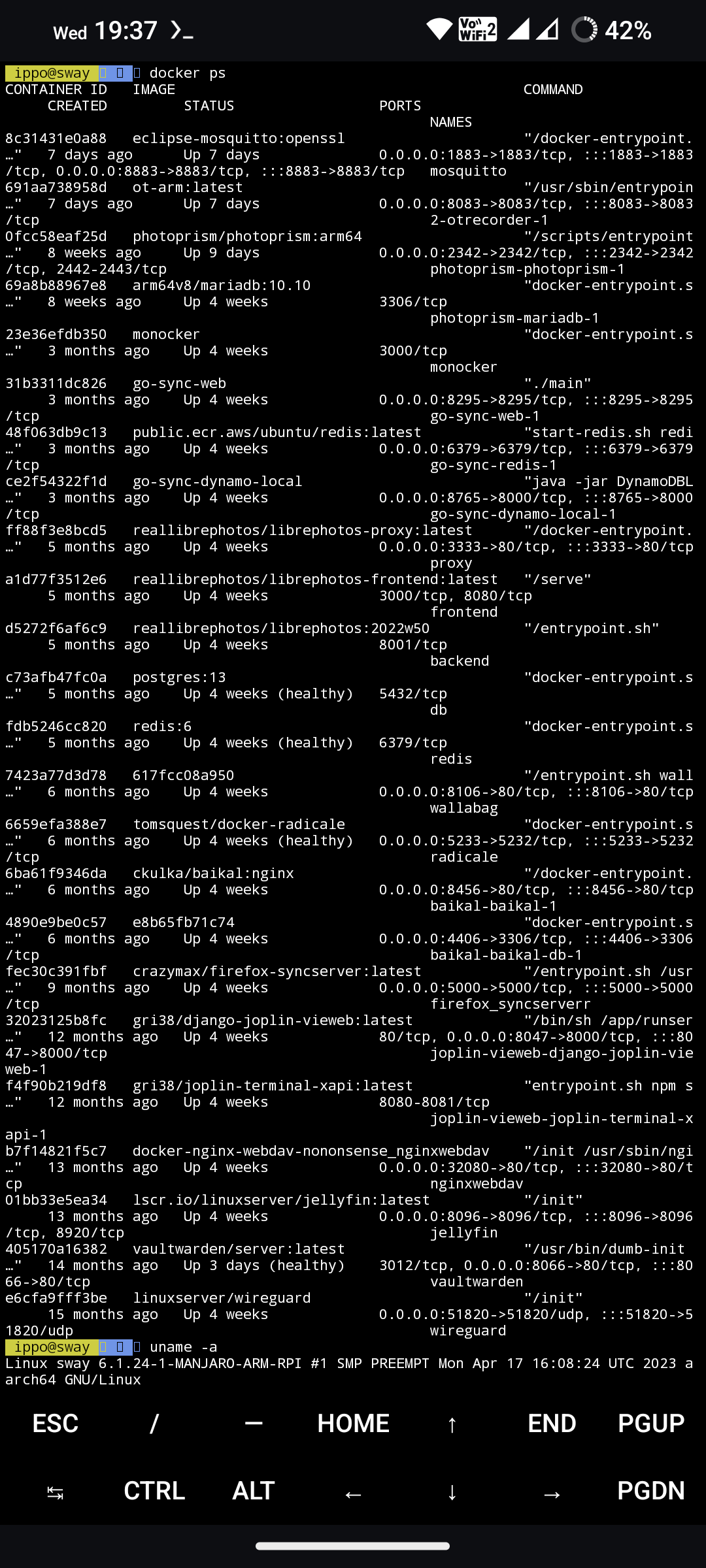For those of you who use Raspberry Pi’s in your home environment, I’m curious as to what you use them for. What applications are you running on them? Do you have your Pi’s setup in a cluster?
I own a raspberry pi 4. Every time I try to use it, I spend half my time trying to fix the stuttery/non responsive UI by fucking with the compistor and such. And then I give up.
I eventually got a new gaming PC and turned my old one into a Linux server, and haven’t really touched my Raspberry Pi since.
Try running a server image on it without desktop and then logging into it over the network from another device like a laptop via ssh
My usecase required a GUI. I was trying to have a mini PC connected to my TV to watch live sports games in a web browser (pirated streams). I was getting micro stutters with a raspberry pi, which made sports unwatchable.
I had similar problems doing the same thing with a Pi 4.
RPI4/400 is perfectly capable as a little home server. All it needs is a good SD card.
Owntracks,photoprism,monocker,brave go m-sync,libre photos,wallabag,radicals e,Baikal,Firefox sync,Joplin web,webdav server,jellyfin,vaultwarden,wireguard

Get an eMMC module ($10) for the Pi or buy something similar with one built-in. Much faster and more reliable.
I have one 3B running adguard and a wireguard vpn server. Another 4B doing the same, plus kitchenowl and home assistant.
Only use it as a backup pihole now. Used to have an *arr stack on it, but needed a beefier pc
I have four Pis. They’re running Pihole DNS & DHCP, a reverse proxy, and torrent clients. I don’t have them setup as a cluster, been meaning to look into it but I don’t want to add complexity so I’m putting it off.
Acronyms, initialisms, abbreviations, contractions, and other phrases which expand to something larger, that I’ve seen in this thread:
Fewer Letters More Letters DNS Domain Name Service/System HA Home Assistant automation software ~ High Availability HTTP Hypertext Transfer Protocol, the Web IP Internet Protocol MQTT Message Queue Telemetry Transport point-to-point networking NAS Network-Attached Storage NUC Next Unit of Computing brand of Intel small computers PiHole Network-wide ad-blocker (DNS sinkhole) Plex Brand of media server package RPi Raspberry Pi brand of SBC SATA Serial AT Attachment interface for mass storage SBC Single-Board Computer SSD Solid State Drive mass storage SSH Secure Shell for remote terminal access VNC Virtual Network Computing for remote desktop access VPN Virtual Private Network VPS Virtual Private Server (opposed to shared hosting) Zigbee Wireless mesh network for low-power devices nginx Popular HTTP server
[Thread #170 for this sub, first seen 27th Sep 2023, 16:05] [FAQ] [Full list] [Contact] [Source code]
Lets see…
- nord vpn client
- qbittorrent (through nord vpn)
- proxy server (through nord vpn)
- wireguard vpn server
- ssh client so I can port forward through the vpn server to/from connected clients
- jellyfin
- ntfy (self hosted notifications)
- pi-hole (vital for the local dns)
- nginx
- gitea
- wallabag
- minecraft server
- container registery
- smb share for my friend (I help them with content creation)
- smb share for a live recording profile I set up on android
Those are just docker containers, it also is a backup server for all the devices I own. It also runs all non sensitive data on an unencrypted partition then will auto decrypt the sensitive partion through ssh via my desktop. This means my vpn server will always run so I can connect, wake on lan my desktop, decrypt it and log in. Im sure I’m missing things.
My list is very similar but I have my Pis in a k3s cluster with a NAS for PVs. That allows me to not worry about what physical device is hosting the service, and I built it so I can intermix amd64 devices when I start adding in my used laptops into the mix.
I feel old, I don’t understand 90% of words in this thread lol.
I just have kodi on Libreelec with a jellyfin plugin on my rpi4 and even that struggled with overheating at times. So I run most stuff on my pc instead. I’m tempted to try the portainer to get some experience with docker tho.
I have 2 Pi 4s in operation. One is a Moonlight/USBoverIP stream gaming portal. It automatically turns on and connects to a VM running Sunshine on my Proxmox host, passes any USB controllers/bluetooth etc to the VM so the big loud gaming box is in the basement and the tiny Pi is next to the TV. 1080p60 works great, minimal lag.
The other acts mostly as a quorum server for the proxmox servers, I have two proxmox hosts and use the second Pi to ensure the cluster doesn’t get split brain. It also acts as a USBoverIP host for my home automation Zigbee and Zwave usb sticks, so that either proxmox host can connect to the USB sticks and the home automation VMs aren’t locked to a physical host.
Cluster of Pi4 8GBs. Bought pre-pandemic; love the little things.
Nomad, Consul, Gluster, w/ TrueNas-backed NFS for the big files.
They do all sorts of nifty things for us including Nightscout, LanguageTool OSS, monitoring for ubiquiti, Nextdrive, Grafana (which I use for home monitoring - temps/humidity with alerts), Prometheus & Mimir, Postgres, Codeserver.
Basically I use them to schedule dockerized services I want to run or am interested in playing with/learning.
Also I use Rapsberry Pi zero 2 w’s with Shairport-sync (https://github.com/mikebrady/shairport-sync ) as Airplay 2 streaming bridges for audio equipment that isn’t networked or doesn’t support AirPlay 2.
I’m not sure I’d buy a Pi4 today; but they’ve been great so far.
I use mine as a minimalistic NAS and media server
Yeah but they’re really only good for single purpose things I keep killing sd cards trying to do more.
Boot from USB is your friend! Use a USB to SSD connector and boot from SSD. Havent had a single storage problem since I switched to SSD :)
I have a Pi4 running octoprint, pi-hole and some of my own containers.
The rest I run on a Hetzner VM.
I have 3 of the 3rd generation ones to mess around on.
Using Pi’s to run services in my homelab which I want to keep separate from my server (to have some sort of failover in case the server goes down). Status/Monitoring, VPN server and so on
That’s a smart idea. Separating services across devices seems like something a low powered PC would be a great use for.
Thanks for the great sarcasm mate
I wasn’t being sarcastic. I’m apologize if I missed something though.
Apologies accepted, seems like I missed something:)







